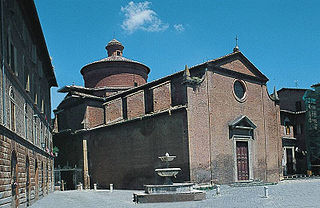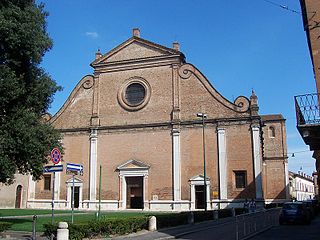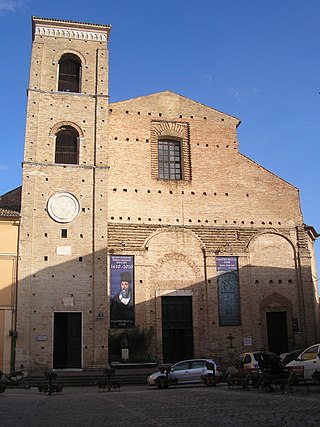San Biagio is a romanesque-gothic style Roman Catholic church. It was erected during the 14th century in the town of Montecatini Val di Cecina, province of Pisa, in the region of Tuscany, Italy.

San Biagio is a romanesque-gothic style Roman Catholic church. It was erected during the 14th century in the town of Montecatini Val di Cecina, province of Pisa, in the region of Tuscany, Italy.

The church was erected in 1356 under the patronage of Ugolino Guducci and Ciullo Barletti. It was consecrated in 1361. In 1421 the duties of the parish church of Gabbreto, then in ruins, along with its baptistry were transferred here to San Biagio. The bell tower was built between 1463 and 1467. In addition the choir was frescoed by an anonymous Sienese painter commissioned by Nicola Nieri of Montecatini.
Between 1514 and 1576, construction of canon's quarters led to sealing of the original facade. Flanking the main altar are two marble angels, called ciechini, attributed to Mino da Fiesole. In the niches above the choir are two terracotta statues by the studio of Della Robbia, depicting Saints Blaise and Sebastian.
In 1787, upon the deconsecration of the Oratory of Camporciano, the statue of the Madonna di Camporciano was moved here. [1]
The church also displays an altarpiece depicting the martyrdom of St Sebastian with Saints Blaise and Antony Abbott, painted by Neri di Bicci. [2]

BartolomeoMontagna was an Italian Renaissance painter who mainly worked in Vicenza. He also produced works in Venice, Verona, and Padua. He is most famous for his many Madonnas and his works are known for their soft figures and depiction of eccentric marble architecture. He is considered to be heavily influenced by Giovanni Bellini, in whose workshop he might have worked around 1470. Benedetto Montagna, a productive engraver, was his son and pupil and active until about 1540. He was mentioned in Vasari's Lives as a student of Andrea Mantegna but this is widely contested by art historians.

San Francesco a Ripa is a church in Rome, Italy. It is dedicated to Francis of Assisi who once stayed at the adjacent convent. The term Ripa refers to the nearby riverbank of the Tiber.

San Carlo ai Catinari, also called Santi Biagio e Carlo ai Catinari, is an early-Baroque style church in Rome, Italy. It is located on Piazza Benedetto Cairoli, 117 just off the corner of Via Arenula and Via dei Falegnami, a few blocks south of the church of Sant'Andrea della Valle.

San Francesco della Vigna is a Roman Catholic church in the Sestiere of Castello in Venice, northern Italy.

Santo Spirito is a Renaissance style, Roman Catholic church located in piazza Santo Spirito, where Via dei Pispini meets Vicolo del Sasso, in Siena, Italy.
A number of towns, sites, and churches in Italy and Italian-speaking areas are named after Saint Blaise, including:

Cathedral of Saint Mary of the Assumption in Ruvo di Puglia is a Roman Catholic cathedral in Ruvo di Puglia, an historic and a City of Art in Apulia, southern Italy, dedicated to the Assumption of the Virgin Mary. Formerly the episcopal seat of the Diocese of Ruvo, it is now a co-cathedral in the Diocese of Molfetta-Ruvo-Giovinazzo-Terlizzi. The building is an important example of late Apulian Romanesque architecture, built between the 12th and 13th centuries, with several later alterations.

The Basilica of St. Sebastian is a church in Barcellona Pozzo di Gotto, Sicily, Italy, raised to the status of a minor basilica in 1991.

San Giovanni Battista is a Baroque-Mannerist style, Roman Catholic church located at the crossing of Via San Giovanni and Via Carraia in central Livorno, region of Tuscany, Italy.

San Francesco is a late-Renaissance, Roman Catholic minor basilica church located on via Terranuova in Ferrara, Emilia-Romagna, Italy.

Ostuni Cathedral is a Roman Catholic cathedral in Ostuni, province of Brindisi, region of Apulia, Italy. The dedication is to the Assumption of the Virgin Mary. Formerly the episcopal seat of the Diocese of Ostuni, it has been since 1986 a co-cathedral of the Archdiocese of Brindisi-Ostuni.

San Biagio is a Neoclassical-style, Roman Catholic collegiate church located in the town of Pollenza, province of Macerata, region of Marche, Italy.

Macerata Cathedral is a Renaissance-style, Roman Catholic cathedral dedicated to the St Julian in the town of Macerata, province of Macerata, region of Marche, Italy.
San Biagio is a Roman Catholic church and monastery in the municipality of Aversa, province of Caserta, in the region of Campania, southern Italy.

Santa Maria or Santa Maria a Campi is a Roman Catholic parish church located on Via Spartaco Lavagnini #26 in Campi Bisenzio, just west of Florence, in the region of Tuscany, Italy.

Sant'Andrea is Roman Catholic church in Montecarlo, province of Lucca, region of Tuscany, Italy.

Santa Agata al Carcere, sometimes called Santo Carcere or the Carcere church is a Roman Catholic church located on Piazza Santo Carcere #7, in the city of Catania, Sicily, southern Italy. It is one of three nearly adjacent churches dedicated in honor of St Agatha of Sicily in this neighborhood, the other two being Sant'Agata alla Fornace and Sant'Agata la Vetere.

San Sebastiano is a Baroque-style, Roman Catholic collegiate basilica church located on Piazza Lionardo Vigo in central Acireale in the region of Sicily of Italy. The church became collegiate in 1924; and basilica in 1990.

San Gregorio Magno is the Roman Catholic chiesa madre or mother church located on the corner of Via San Gregorio Magno and Largo Matrice, in the center of the town of Vizzini, in the region of Sicily, Italy. It rises near the basilica church of San Vito Martire.

Santissimo Crocifisso is a Roman Catholic parish church, located in the center town of Pontedera in the province of Pisa, Tuscany, Italy.